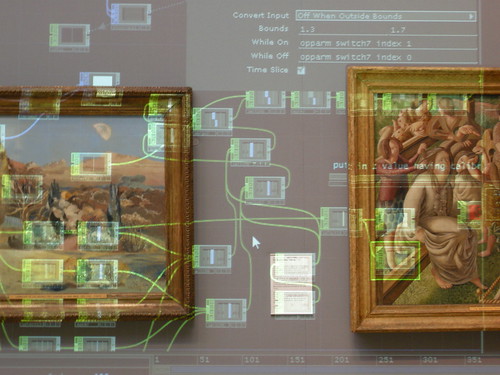Inkvisible #4: smooth moves and scribbles
Today was our last day of Inkvisible playtesting. Having decided to move away from the L.A.S.E.R Tag software to a motion-tracking based system, it turns out we still stayed with the Graffiti Research Lab.
Ben Eaton hacked an installation of BlitzTag to work with a Kinect sensor.
After a bit of configuration for the space, we started getting our first curious bystanders.
They rapidly became participants!
The first observation was that this system gave much smoother results. Strangely the projected line almost felt elastic at times. The second was that people seemed to get really very absorbed into the movements – in the same way that you might run your fingers through sand on the beach or trail them through water. It’s quite a different experience from the version that tracks a laser pointer. This is much more about the movement of the body.
The snippet of video gives a small sense of this, but basically we were finding that people (of all ages) were doing this for several minutes, content to just swirl their arm around and see the traces formed.
With very few exceptions, the results all looked like this:
Although we did have one or two cases of people writing their names:
People seemed to filter out the paintings we were hoping they might respond too. I think most people would have preferred to have had a blank area of wall to mark onto.
This, however, was not what we were trying to investigate so, time to change things up a little!
We relocated to the gallery next door and set up over an abstract painting. Here we wanted to see if we could find a base layer that resonated more with the projected graffiti layer.
It started to show some promise, so we did a slow pan of the room to see what different scales and substrates did.
I very much liked the feel of working on a huge scale as when happened when the projector reached down to the far end of the room. The corresponding drop in intensity was noticeable though, in that the lines were quite faint. It would be really good to try something on this scale, but with a much more powerful projector so that the results are still vibrant.
Next we came to Ana Maria Pacheco’s Man and His Sheep.
Oh yes.
Now we started to be actually interacting with the artwork. Admittedly still through kind of scribbling, but when you mark across a face, a part of you feels it on your face too.
So, this was significant not only for the shift in interaction, but also because this was the first time we had been able to successfully project onto 3D sculpture (reflection and scatter problems with the lasers).
Both systems we trialled have their pros and cons. In particular with this one we missed the ease of being able to tweak settings and the effect of the paint drips.
As with L.A.S.E.R. Tag, BlitzTag was not without its quirks when it came to problems with tracking. For some reason it simply would not detect and respond to the movements of several people.
We weren’t really in a situation that enabled us to do de-bugging of what was causing this, but we suspect it to be partly to do with differences in clothing.
The system was generally able to detect me, so we devised a couple of work-arounds that sometimes worked. The first was to give people my brown shirt to wear (see above) and the other was for me to stand in front of people to act as a sort of shield.
In summary we think this has got a lot of potential, but we think any next steps would benefit from a particular context (giving a direction to the types of responses being sought) and a big chunk of time that could be spent de-bugging the installation and customising the nature of the projections.
That’s us out of time, though. Next week we report our findings back at King’s College.















